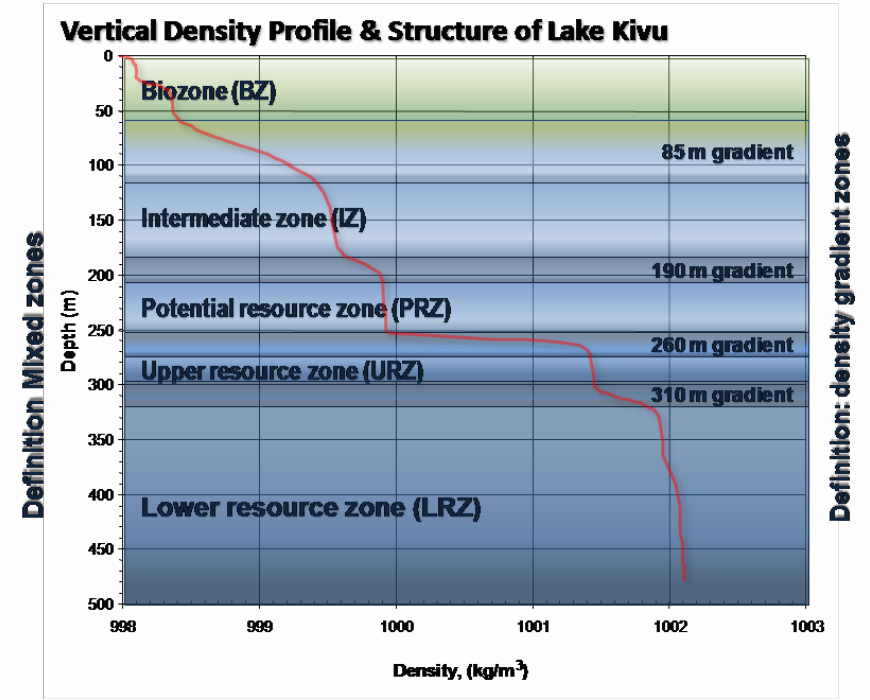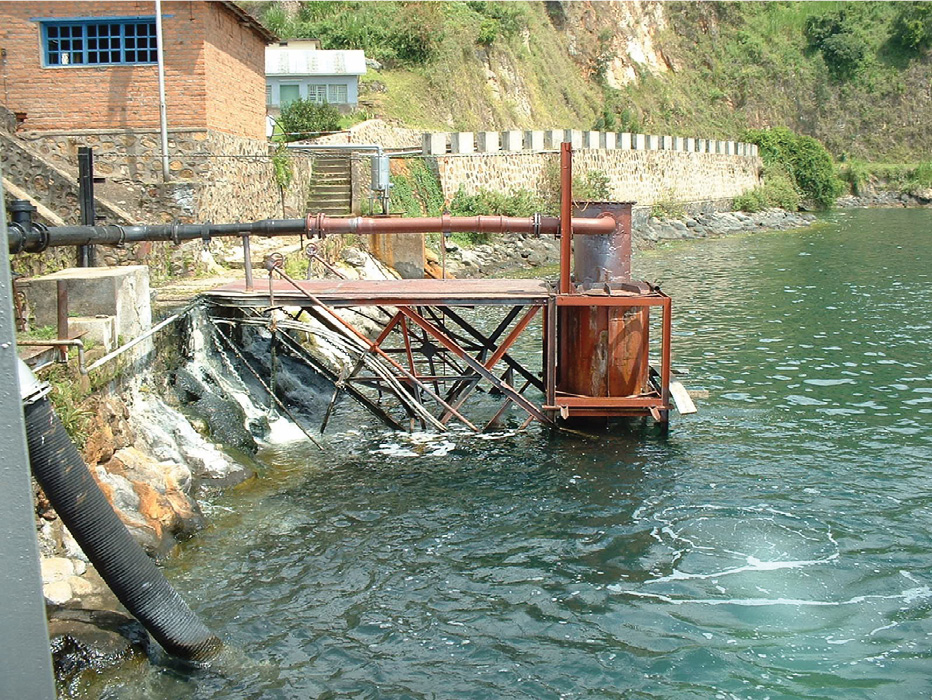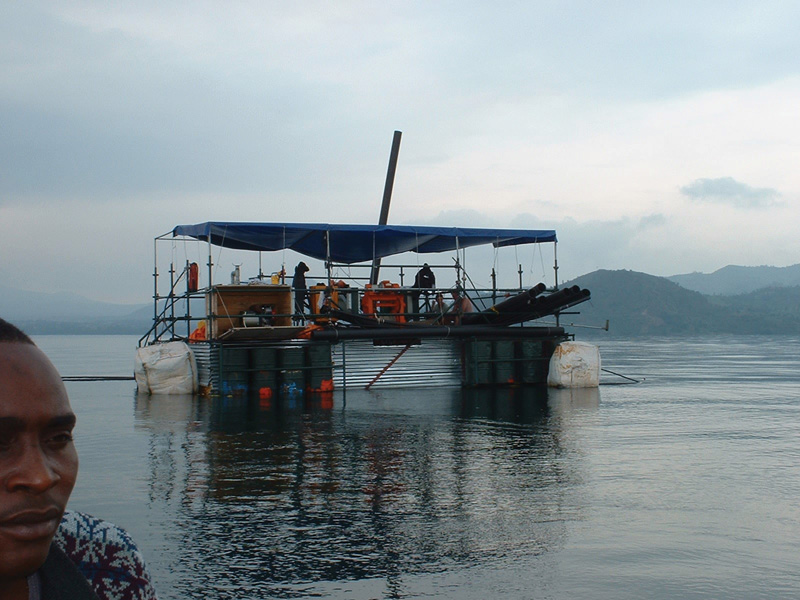In Johannesburg in 1998, a Rwandan government delegation came looking for assistance to develop an energy supply for their country. They offered access to Lake Kivu, one of four lakes in Africa’s Western Rift Valley, for development. They reported that it encompasses a unique trap for anoxic biogas formation and storage, providing enormous, dissolved gas reserves, notably methane. They explained how gas capture here had started in 1965, fuelling a local Heineken brewery. In short, they wanted to provide more energy to the country but were struggling to garner interest and commitments in the area. This is an incredible resource, with associated dangers, providing unique technical challenges to develop it effectively and safely.
Lake Kivu’s Fiery Formation
The highest of Africa’s Great Lakes, Kivu, straddles the border between the Democratic Republic of the Congo (DRC) and Rwanda (Figure 1). It lies in the Albertine Rift, the western branch of the East Africa Rift. The lake has a surface area of 2,400 km2 with a surface elevation 1,463m above sea level. It is positioned over the rift’s most active zone, where tectonic movement is gradually splitting the Somali Plate away from the rest of the continent. This rifting zone is underlain by shallow magma, a hot spot that has spawned a string of volcanoes. Two of the seven main peaks still lie above the hot zone and remain very active. Other peaks like Mt Karasimbi, 4600m high, have drifted up to 100 km east with tectonic movement. Mt Nyiragongo had a flank spill on 22 May 2021, with lava flowing to within 5 km of Lake Kivu. Rifting action made the lake deep, despite sediments deposited on the lake floor. Surrounding hills plunge steeply into deep water, with a maximum depth of 486m and with an average of 220m. It is the world’s eighteenth deepest and the ninth deepest lake by mean depth.
How Did It Get Full of Gas?
The Lake Kivu methane is biogenic in origin, formed by the acetate pathway which also produces CO2. Anaerobic bio-digestion of dead organic matter (algae and fish) occurs on the floor of the lake. Other pathways such as methanogenesis exist, where archaeal methanogens can convert some of the volcanic or biogenic CO2 to methane. Most gas is renewable, with a current renewal rate averaging 0.5% per annum. Indications of a varying rate of renewal over recent decades may be due to the variety of measurement techniques, combined with a varying flux of nutrients from depth into the Biozone. Lake Kivu is estimated to contain approximately 55–60 billion m3 (1.9–2.0 Tcf) of dissolved biomethane, mostly below a depth of 260m. It also contains roughly 300 billion m3 of CO2, similarly, distributed by depth.
Lake Kivu’s extraordinary feature is stratification and resultant quiescence and stability of the deep waters. The vertical density profile is a key feature defining the lake’s behaviour. No other lake is known to have five distinct strata. Unusually the deepest waters are the warmest, over 26°C. Oxygenated water persists in only the uppermost 60m Biozone layer. This Biozone supports aquatic life in the form of small, sardine-like fish called ‘sambaza’. Seasonal wind-driven turnovers oxygenate the Biozone, occurring more strongly in the dry seasons. Oxygenation penetrates to a depth of up to 60m, but oxygenated water depletes seasonally to as shallow as 40m during the calmer, wet seasons.
The deeper layers get progressively denser with depth, bearing increasing concentrations of salts (mainly of magnesium carbonates and sulphates) and nutrients. Subaquatic inflows of varying density create the density layers that separate the lake into definable strata. Figure 2 shows these density gradients, illustrating the defined zones. Gradient layers act as virtual traps, preventing significant vertical migration of gases out of the main gas resource zones.
A Resource and a Danger
Along with Cameroonian Lakes Nyos and Monoun, Kivu is one of three known to undergo limnic eruptions or lake overturns. The smaller crater lake events are rare, but more frequent. Dissolved CO2 can catastrophically erupt from deep crater lake waters when triggered, i.e., by landslides. Eruptions similarly form a dense gas cloud, capable of suffocating wildlife and humans. This phenomenon has been observed in Cameroon at Lake Monoun in 1984, causing asphyxiation and death of 37 people and at neighbouring Lake Nyos in 1986, which released over 80 million m3 of CO2. This more destructive limnic eruption killed over 1,800 people.
At Lake Kivu, core samples from lake-bed sediment showed uneven strata, indicating disruptive events at time intervals of several millennia. Careful evaluation of data indicates few eruptions or ‘turnovers’ have occurred, one of which coincided with a prolonged drought period and a sharp drop in lake level 1,500 BC. These events emit 10,000 times more gas than crater lakes.
Limnic Eruptions from Lakes
For a limnic eruption to occur, there must be concentrations of dissolved gas (in Kivu’s case, methane and CO2) approaching saturation. It also needs an energetic trigger event, displacing a large volume of gas-saturated water upwards, to where pressure cannot keep the gases in solution. A rising column of degassing water initiates a surging gas-lift. Triggers are typically a volcanic eruption, or major seismic rift event. An alternate cause of limnic eruption is a gradual rise in gas saturation, which will take decades. Pressures peak at specific depths, such as 275m and 320m, which is where spontaneous gas eruption can trigger as 100% saturation occurs.
The active volcanoes are the 10,000-year-old Mounts Nyiragongo and Nyamulagira, lying 25 and 40 km to the lake’s north. As recently as 22 May 2021 there was an eruption, with lava flows not quite reaching Lake Kivu to the south. A very similar flank spill in 2001 did reach the lake after streaming through the city of Goma, penetrating to 80m depth before solidifying.
The compositions of gas releases from lakes are unique to each, and Lake Kivu has a signature gas content in the anoxic zone of 20% methane and 80% carbon dioxide. Minor components include nitrogen, hydrogen sulphide and argon.
What the Eruption Process May Look Like
From the surface of the lake, if you were unlucky enough to be caught in an eruption’s epicentre, the waters initially smooth out with fine, rising bubbles. The ferocity would rapidly escalate, appearing to boil. The odour of H2S, like rotten eggs, would hit you strongly, but in seconds destroy your sense of smell. The rapidly rising waters would surge upwards and outwards, eventually causing tsunami-like concentric waves. Visibility would be clouded in fog.
The eruption’s core could eventually grow wider than 1 km in diameter, from where a rapidly forming, low gas cloud would blast outwards. It is estimated that this eruptive ‘storm’ continues for 24 hours before it becomes depleted. At the surface, tsunami-like waves, metres high and a storm-surge in water level, would radiate rapidly outwards to all shores. Consequences for riparian populations living in settlements close by (Goma, Kabare, Kalehe, Bukavu and Sake in Congo, and Gisenyi, Kibuye, and Cyangugu in Rwanda) would be catastrophic. When the clouds finally clear, a muddy lake would reappear, as will a lifeless shore, smelly, and still deadly.
An Unexpected Opportunity
Following that first engagement, I was initially sceptical of the 1998, Rwandan delegation’s mission to promote Lake Kivu as a gas resource. I called a chemical engineering expert in Cape Town, Gareth Shaw, who told me about his visit to the area in 1998. His reconnaissance report elicited little interest from his company, but he was able to share the technical findings with me. They were interesting and seemed plausible, though prompting further investigation.
A few years later in 2001, I was contacted by an ex-Fluor colleague, Mike Sterne. He worked for Murray & Roberts, a leading engineering and construction group based out of Johannesburg, and they were contemplating a trip to Rwanda. He asked if I would participate because of my African gas experience. I agreed and flew out to Rwanda just before Christmas 2001. At the Energy Ministry in Kigali, we worked through numerous reports on the feasibility of developing the Lake Kivu gas reserves, including an Egyptian study advocating a floating plant offshore. The following day we travelled north to Gisenyi, a city on the northern shore of Lake Kivu.
Gas Extraction
We were asked to look at the earlier venture to exploit the Kivu gas resource, a 1965 facility, UPEGAZ, built by UCB of Belgium. UPEGAZ was a land-based project for gas extraction on a Kivu peninsula close to deep water. When we visited the plant, it still limped along, though rusted and patched up. From the rotten-egg stench, it seemingly leaked as much gas as it piped to the brewery 2 km to the south. We were able to validate the still-working process, although in expanding the existing facilities there was not a viable onshore solution.
We later surveyed Kivu from the UPEGAZ facility, and in the process, I had formed the kernel of an idea: building an offshore facility in deep water with 400m risers, but with all processing modules submerged. This solution would be elegantly simple, continuously operable with minimal attention and maintenance. The concept was sketched out on the return flight and a recommendation made to Murray & Roberts to evaluate further.
Feasibility and Piloting
I worked with the Murray & Roberts projects team, leading the pre-feasibility study, comparing new and legacy ideas. The new concept was more promising, but unproven. The idea was to accelerate gas exsolution, and after months of research, including a visit to Boston to engage experts in underwater sonar, we found leading expertise just 10 km away in Johannesburg. We then designed a scaled-down pilot module, barge-mounted, on a shoe-string budget.
The pilot was a proof-of-concept and by November 2003, our expanded team mobilised to Rwanda. The pilot-rig (Figure 5) was procured, shipped and built on the lakeshore but once launched, getting it working was not easy. The new technology, though used for submarine detection, experienced leakage in cables and seals resulting in having to hand-haul the module out several times, over the small deck, to inspect and re-install. Several nights we were raided by fishermen, despite posting guards, with the raiders cutting anchor ropes and piping and then offering to sell them back to us.
Hard-won Success and Setback
On 26 January 2004, our gas-lift began working and gas flow started, igniting the flare. The government scheduled demonstrations of the technology while we collected data. The Minister of Energy enquired about operating it permanently by piping gas to shore, as it produced as much gas as the UPEGAZ facility. We advised not, but hosted potential investors, including South Africa’s IDC, until southerly winds started blowing in May. We demobilised the rig to shore because the waves became too rough for safe operations. Data, confirming our earlier simulations, allowed carrying out full-scale designs. The barge fulfilled its purpose.
The completed test-work strongly supported full feasibility assessment and the results were presented to Rwandan investors and then to government leaders. But momentum by the early promoters slowed, outside factors interfered and a Murray & Roberts management reshuffle resulted in a decision not to participate, with focus shifting to the nuclear Pebble Bed Reactor (PBMR) project in 2005, a joint venture with SNC-Lavalin. I was asked to co-lead that project team, forcing a break from the Kivu project.
Experts of the World Unite
In February 2007, a World Bank-sponsored conference was hosted in Gisenyi, with European diplomats, scientists, developers, and government delegations. The Kivu gas development experiences, theories and perspectives were presented, receiving new attention. But for the conference, consensus seemed distant with so many diverse opinions. After hearing of our gas extraction experience, the organisers co-opted me along with five scientists to ‘quickly’ confirm the 1986 rules for lake use.
Three years later our Expert Group published the lake management prescriptions, based on the workability of alternative extraction concepts. Designs based on the 1965 legacy approach would destroy the natural safety structure of a stratified lake structure. By May 2009, we also concluded that legacy approaches and ours were incompatible for simultaneous use. A legacy approach may be safe for 30–40 years, deteriorating thereafter to being a danger for centuries.
The Management Prescriptions for Lake Kivu Development (MPs) were issued in January 2010 in English and French, and both Rwanda and DRC adopted them through enabling legislation.
Renewed Investment Search
Later in 2007, the Rwandan Investment Group (RIG) engaged Hydragas, requesting a proposal for a feasibility study. We started the six-month study in 2008 but cancelled when payments were not forthcoming. We substantially completed our own feasibility study with contractors. RIG switched to backing a French team whose concept later failed. Another investor, from California, stepped in for us after RIG’s pull-out. In 2008 we negotiated a $25 million investment with Kenyan co-investors, but with famously bad timing: the Global Financial Crisis hit on 1 August.
New Competition
In 2008, New York-based investors accompanied President Bush on Air-Force One to Kigali. They were introduced to Rwanda as the team who would resolve Rwanda’s energy problems, producing 100 MW of clean power by 2010. Five years late, they had built a quarter of the promised capacity, using most of their capital. The unit still operates but remains unable to make a return on investment. In 2015, a copycat investor, also with investment and Presidential endorsement, embarked on the same road with the same engineers. But their feasibility study to secure an environmental and social impact assessment was rejected. Their study and rights were sold, and new owners were allowed to build a smaller demo facility, now in construction.
Taking a Break and Restarting
In 2011, I emigrated to Canada, working for eight years on large international resources projects, mainly gold and LNG. I remained aware of ongoing attempts to improve the performance and safety of Kivu’s gas projects and in 2018, I registered a company to re-open development of Lake Kivu and commenced start-up fundraising. We believe we can develop this resource, so needed by the local communities, in a sustainable way that prevents disrupting the critical balance of the water layering at Kivu. With the right gas extraction method, the lake’s risk of limnic eruption could drop by as much as 99% within 20 years – surely a worthwhile end game.










